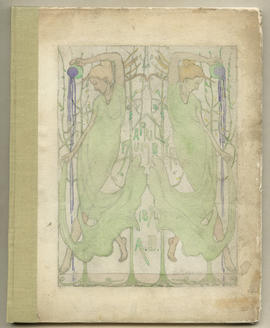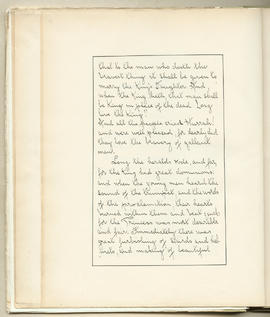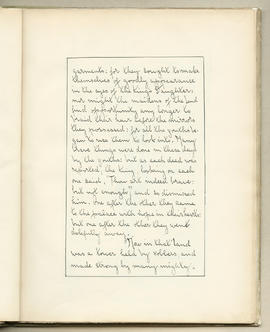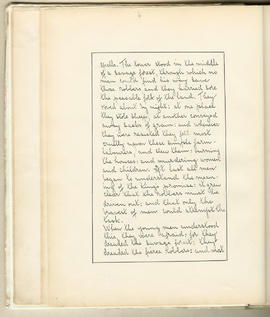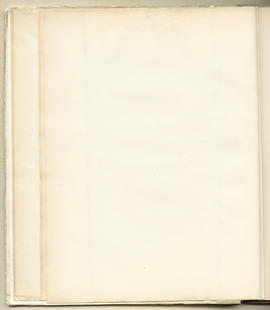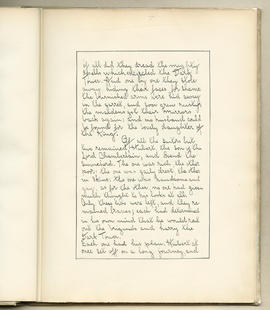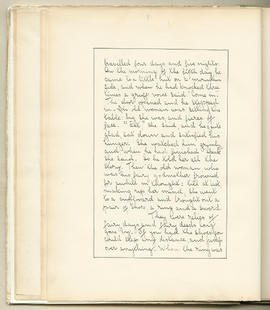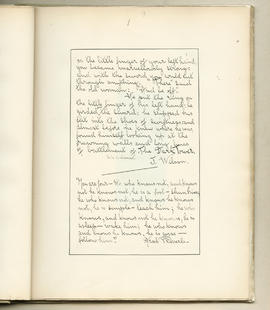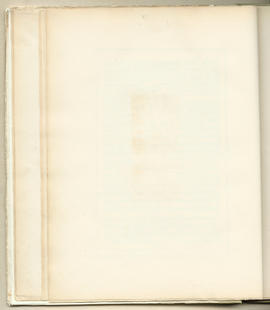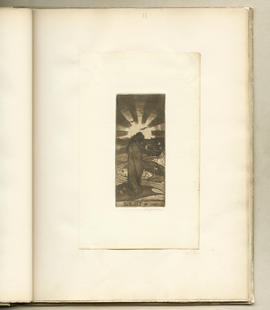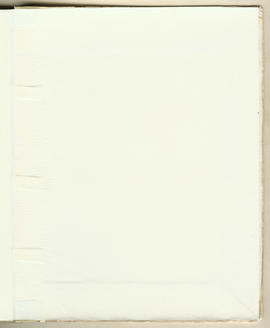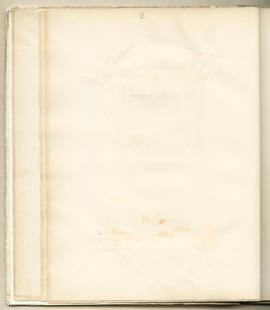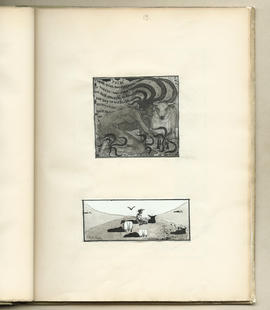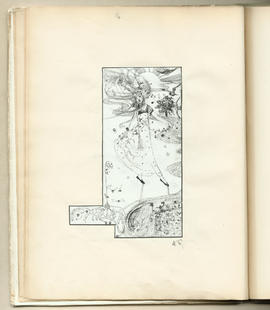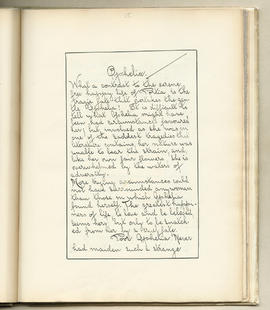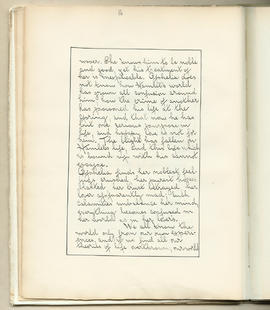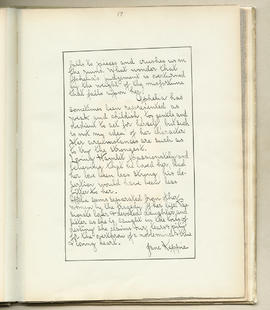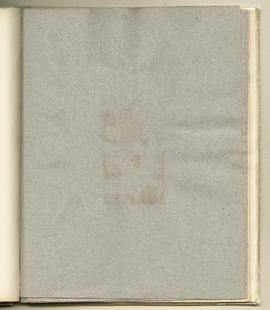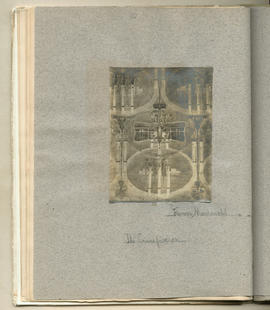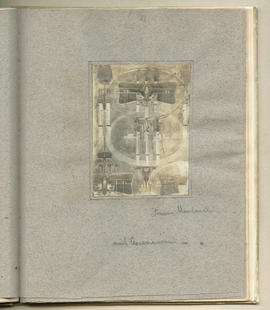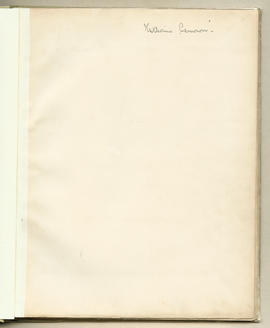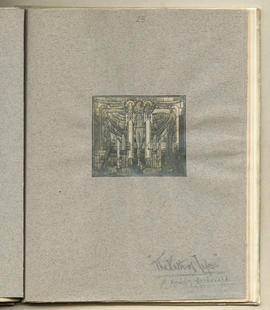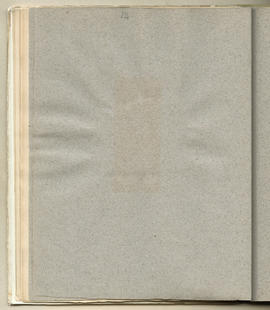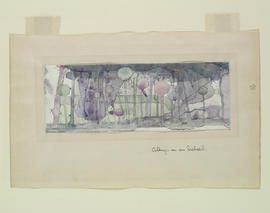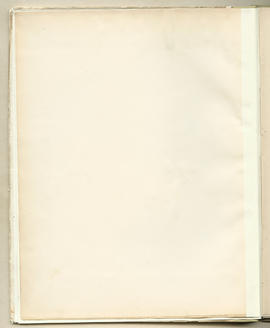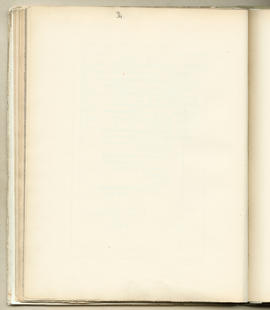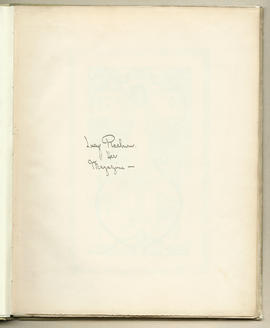Key Information
Reference code
Title
Date(s)
- 1893-1896 (Creation)
Level of description
Folder
Extent
4 volumes
Content and Structure
Scope and content
There are 4 known surviving volumes: The Magazine 1893, The Magazine April 1894, The Magazine November 1894, The Magazine 1896.
The Magazine was a publication of original writings and designs by students from the Glasgow School of Art, Glasgow, Scotland, and their friends. Appearing in 4 volumes between November 1893 and Spring 1896, The Magazine contains text from contributors handwritten by Lucy Raeburn, editor, accompanied by original illustrations. These volumes are the only known copies of The Magazine. In addition to rare, early watercolours and designs by Charles Rennie Mackintosh, the volumes contain early designs by Frances MacDonald and Margaret MacDonald, at a stage in their development which has been labelled 'Spook School', and two sets of photographs by James Craig Annan, when he was beginning to establish a reputation at home and abroad. Among other contributors were Janet Aitken, Katherine Cameron, Agnes Raeburn and Jessie Keppie, all of whom enjoyed lengthy careers in art and design.
The Magazine is similar to an album amicorum such as those which originated in the middle of the 16th century among German university students, who collected autographs of their friends and notable persons, sometimes adding coats of arms and illustrations. The Magazine resembled the album amicorum in that contributions were by a close group of students and their friends and is all the more interesting because the illustrations were produced by young people who had a common social background, were trained at the same school, and subjected to the same artistic influences. The contributors were closely linked, some by family, some by romantic attachments and had close social connections. Other contributors include C Kelpie, John M Wilson, Jane Keppie, and Ethel M Goodrich. Source: Jude Burkhauser, Glasgow Girls: women in art and design (Edinburgh : Canongate, 1990).
Appraisal, destruction and scheduling
Accruals
System of arrangement
General Information
Name of creator
Name of creator
Biographical history
Frances Macdonald’s achievements are less well known than those of her sister, Margaret Macdonald. In part this is due to the loss of much of her work, destroyed by her husband, Herbert McNair, after her death, and in part to the fact that she left Glasgow in 1899. Nonetheless she produced some of the most powerful imagery of the Glasgow Style, and her late symbolist watercolours are moving meditations on the choices facing women.
Frances was born in England and moved to Glasgow with her family by 1890. She enrolled as a student at Glasgow School of Art recording her address as 9 Windsor Terrace, Glasgow.
GSA records reveal a successful school career:
1891: Local exam., advanced, Stage 23c, ornamental design, 2nd class
1891: Local exam., advanced, Stage 10a, plant drawing in outline, 2nd class
1891: Local exam, 2nd grade certificate, freehand drawing, 2nd class
1892: National Competition, Bronze medal, Stage 23d, des for majolica plate
1892: Local exam, advanced, composition from given figure subject, 2nd class
1892: Local exam, advanced, painting in monochrome, 1st class
1892: Local exam, advanced, design, honours stage, 1st class
1892: Local competition, design, majolica, prize
1893: Local exam, advanced, drawing from the antique, 2nd class
1893: Local exam, advanced, design, honours stage, 1st class
1893: Local exam, advanced, principles of ornament, 2nd class
1893: Local exam, advanced, model drawing, 1st class
1893: Local exam, advanced, drawing in light and shade, 1st class
1893: Local competition, design section, hangings, 1st prize 1908/10 1908/10: art needlework and embroidery, design and instruction 1908/10: enamels, design 1908/10: gold and silversmithing, design 1908/10: metalwork, repousse &c, design
GSA Staff, Design Dept 1908/10
1908/10: art needlework and embroidery, design and instruction
1908/10: enamels, design
1908/10: gold and silversmithing, design
1908/10: metalwork, repousse &c, design
It was at GSA that she met Charles Rennie Mackintosh and Herbert McNair. In the mid 1890s Frances left the School and set up an independent studio in the city centre with her sister, Margaret Macdonald. Together they collaborated on metalwork, graphics, textile designs and book illustrations, exhibiting in London, Liverpool and Venice.
Following her marriage in 1899 to Herbert McNair she joined him in Liverpool where McNair was by then teaching at the School of Architecture and Applied Art. The couple designed the interiors of their home at 54 Oxford Street and exhibited a Writing Room at the International Exhibition of Modern Art, Turin. Macdonald also started teaching, and developed skills in jewellery, enamelwork and embroidery. The closure of the School in the early 1900s led to a gradual decline in their careers, compounded by the loss of the McNair family wealth through business failures. The couple returned to Glasgow around 1909. It was in the following years that Macdonald painted a moving series of symbolist watercolours addressing themes related to marriage and motherhood. She died in Glasgow in 1921.
For further information consult ed. Jude Burkhauser, ‘Glasgow Girls’, Canongate Press, 1990 and Janice Helland, ‘The Studios of Frances Macdonald and Margaret Macdonald’, Manchester University Press, 1995. An exhibition of the McNairs’ work was held at the Hunterian Art Gallery, University of Glasgow, in the summer of 2006, subsequently touring to the Walker Art Gallery, Liverpool from January to April 2007.
Name of creator
Biographical history
Margaret Macdonald was one of the most gifted and successful women artists in Scotland at the turn of the century. Her output was wide-ranging and included watercolours, graphics, metalwork and textiles. Arguably her greatest achievements were in gesso, a plaster-based medium, which she used to make decorative panels for furniture and interiors.
Macdonald was born in England and came to Glasgow with her family around 1890. She enrolled as a day student at Glasgow School of Art, recording 9 Windsor Terrace, Glasgow as her home address.
GSA records reveal a successful school career:
1891: Local exam, advanced, Stage 23c, ornamental design, second class
1891: Local exam, 2nd grade certificate, freehand drawing, 2nd class
1891: Local exam, 2nd grade certificate, model drawing, 2nd class
1891: Local prize, Design section, majolica, 1st prize, 10/-
1891: Local exam., advanced, Stage 9a, anatomy, 1st class
1892: Local exam., advanced, Stage 8c, drawing from life, 2nd class
1892: Local exam, advanced, composition from given figure subject, 2nd class
1894: Local prize, Design section, stained glass design, 2nd prize
It was at GSA she met Mackintosh and Herbert McNair. Leaving the School in the mid 1890s, she set up an independent studio in the city with her sister, Frances. Margaret Macdonald The sisters worked together until Frances’s marriage and departure for Liverpool in 1899. Mackintosh and Macdonald married in 1900.
Collaboration was key to Margaret Macdonald’s creativity. The partnership with her sister in the 1890s produced metalwork, graphics, and a series of book illustrations. Her collaboration with Mackintosh comprised primarily the production of panels for interiors and furniture, notably for the tea rooms and The Hill House. The precise nature of their partnership is difficult to define, because little documentation survives. However it is certain that Macdonald played an important role in the development of the decorative, symbolic interiors of the early 1900s, including the House for an Art Lover portfolio, the Rose Boudoir, Turin and the Willow Tea Rooms.
Ill health and the strain of Mackintosh’s declining career contributed to a decline in her own output and no work after 1921 is known. Macdonald died in London in 1933, five years after her husband.
Name of creator
Biographical history
By the end of the 19th century Glasgow School of Art was one of the leading art academies in Europe and after early success in the fine arts, the late 1890s saw Glasgow’s reputation in architecture and the decorative arts reach an all time high. At the very heart of this success was a talented young architect and designer, Charles Rennie Mackintosh whose reputation was to quickly spread beyond his native city and who, over a century later, is still regarded as the father of Glasgow Style.
Born in Glasgow on 7 June 1868, Mackintosh was apprenticed to a local architect John Hutchison, but in 1889 he transferred to the larger, more established city practice of Honeyman and Keppie.
To complement his architectural apprenticeship, Mackintosh enrolled for evening classes at the Glasgow School of Art where he pursued various drawing programmes. Here under the watchful eye of the headmaster Francis Newbery, his talents flourished and in the School’s library he was able to consult the latest architecture and design journals becoming increasingly aware of his contemporaries both at home and abroad. He won numerous student prizes and competitions including the prestigious Alexander Thomson Travelling Studentship in 1890 that allowed him to undertake an architectural tour of Italy.
Back in Glasgow, Mackintosh’s projects for Honeyman and Keppie during the early 1890s displayed an increased maturity. His design for the Glasgow Herald Building (1894) incorporated some cutting-edge technology including a hydro-pneumatic lift and fire-resistant diatomite concrete flooring. Later at Martyr’s Public School (1895), despite a somewhat restricted brief, he was able to introduce some elaborate but controlled detailing including the central roof trusses.
At a public lecture on architecture in 1893, Mackintosh argued that architects and designers be given greater artistic freedom and independence. He himself began to experiment with a range of decorative forms, producing designs for furniture, metalwork and the graphic arts (including highly stylised posters and watercolours), often in partnership with his friend and colleague at Honeyman and Keppie, Herbert MacNair and two fellow students, Margaret and Frances Macdonald.
In 1896 Mackintosh gained his most substantial commission, to design a new building for the Glasgow School of Art. This was to be his masterwork. Significantly, the building was constructed in two distinct phases, 1897-99 and 1907-09, due to a lack of money. Stylistically, the substantial delay in completion offered Mackintosh the opportunity to amend and fully integrate his original design (of 1896) which owed much to Scotland’s earlier baronial tradition with a second half to the building that looked very much to the 20th century through its use of materials and technology. Most dramatic of all the interiors was the new Library (completed in 1909), which was a complex space of timber posts and beams. Its construction owed much to traditional Japanese domestic interiors but ultimately the building was an eclectic mix of styles and influences.
In Europe the originality of Mackintosh’s style was quickly appreciated and in Germany, and particularly in Austria, he received the acclaim and recognition for his designs that he was never truly to gain at home. He contributed to the 8th Vienna Secession and participated in international exhibitions in Turin, Moscow and elsewhere. He entered an open competition to design ‘A House for an Art Lover’, put forward by a German design journal, Zeitschrift fur Innendekoration, in 1900. Although he failed to win the competition, his architectural designs were judged to be of such a high standard that they were later reproduced as a portfolio of prints.
Back in Scotland at The Hill House in Helensburgh (1904), the publisher Walter Blackie commissioned Mackintosh to design a substantial family home. In its appearance, it owed much to his House for an Art Lover designs and an earlier completed domestic commission, Windyhill (1900). Externally, The Hill House was notable for its simple and solid massed forms with little ornamentation, yet internally the rooms exuded light and space, and the use of colour and decoration was carefully conceived.
Throughout his career Mackintosh relied on just a handful of patrons and supporters. The Glasgow businesswoman Catherine Cranston proved to be one of his most influential and her series of tearoom interiors (designed and furnished between 1896-1917) provided him with a virtual freedom to experiment. Responsible for their ‘total design’ Mackintosh provided the tearooms with furniture (including the dramatic high-back chairs), light fittings, wall decorations and even the cutlery.
Despite success in Europe and the support of clients such as Blackie and Cranston, Mackintosh’s work met with considerable indifference at home and his career soon declined. Few private clients were sufficiently sympathetic to want his ‘total design’ of house and interior. He entered the competition to design a cathedral for the City of Liverpool (1902) but although his design showed a Gothic quality as requested, his entry was rejected and his design for Scotland Street School (1906) in Glasgow was to be his last public commission.
By 1914 Mackintosh had despaired of ever receiving the level of recognition in Glasgow that he felt he deserved. He became increasingly obstinate and incapable of compromise and it is known that this exerted unnecessary pressures on his colleagues. In an attempt to resurrect his career, Mackintosh resigned from the practice and with his wife Margaret Macdonald moved to London.
This was unfortunate timing, for with the onset of the First World War all building work was severely restricted. Adventurous plans for a suite of artists’ studios and a theatre were never built. However, after making adjustments to the exterior of a mid-terraced house at 78 Derngate in Northampton (1916), the client W J Bassett-Lowke commissioned Mackintosh to redecorate a number of the building’s interiors including the Guests’ Bedroom (1919). These designs show him working in a bold new style of decoration and construction, using primary colours and geometric motifs. It was an output of extraordinary vitality and originality but it went virtually unheeded.
A move to the South of France in 1923 signalled the end of Mackintosh’s three-dimensional career and the last years of his life were spent painting. He died in London on 10 December 1928.
Name of creator
Biographical history
Scottish-born Herbert McNair was a highly individual designer and talented teacher. He made an important contribution in the early 1890s to the development of Mackintosh’s creative imagination, and his paintings and furniture designs were among some of the most most individual of the Glasgow Style of the 1890s. The promise of his early career was not fulfilled however, largely because of external factors, and no work after 1911 is known.
McNair trained as an architect with Honeyman and Keppie, Glasgow from 1888 to 1895, where he met Mackintosh. He subsequently set up an independent studio as an artist and designer in the city centre – he never practised architecture. McNair had early success with a one-man show of his pastels in London in 1898 and his appointment that year as a lecturer at the School of Architecture and Applied Art, University College, Liverpool. Frances Macdonald and he married the following year, and their only child, Sylvan, was born in 1900. The couple exhibited work in Vienna (1900), Turin (1902) and Dresden (1903), as well as regularly exhibiting watercolours in Liverpool and London in the early 1900s. Difficulties arose with the closure of the School in 1905. McNair and a colleague set up an alternative school but this experiment was short-lived. Combined with these setbacks, the family wealth had been dissipated through poor business management. McNair and his family returned to Glasgow in straitened circumstances. A final but unsuccessful attempt to re-establish a career appears to have been made with an exhibition of the McNairs’ work at the Baillie Gallery, London. No work by McNair after that date is known. Following Frances Macdonald’s death in 1921, he destroyed much of her work, and subsequently lived in Argyllshire where he died in 1955.
Other examples of his work are held by the Hunterian Art Gallery, University of Glasgow, and the Walker Art Gallery, National Museums Liverpool. There is little published information currently available, except for an early article by Roger Billcliffe in the Walker Art Gallery Annual Bulletin, 1970-1. An exhibition of the McNairs’ work was held at the Hunterian Art Gallery, University of Glasgow, in the summer of 2006, subsequently touring to the Walker Art Gallery, Liverpool from January to April 2007.
Name of creator
Biographical history
Annan, James Craig (1864–1946), photographer, was born on 8 March 1864, the second of the seven children of Thomas Annan (1829/30–1887), photographer, and his wife, Mary Young Craig, at 15 Burnbank Road, Hamilton, Lanarkshire, in Talbot Cottage, named after William Henry Fox Talbot, the inventor of positive–negative photography. He learned about photography as a boy from his father, and after attending Hamilton Academy until 1877 he joined the family firm. In 1878–9, and probably longer, he studied chemistry at Anderson's College in Glasgow. He travelled to Vienna in 1883 to be taught the process of photogravure by its inventor, Karl Klí?; knowledge of this technique was particularly beneficial for his family's business, which specialized in the reproduction of works of art. He made beautiful photogravures about 1890 from the original calotypes taken just under fifty years earlier by his fellow Scots, David Octavius Hill and Robert Adamson: this revived an interest in these early masterpieces of photography. About 1891 Annan decided to follow his own interests as a creative photographer. Springing from the city of Glasgow's artistic stramash, he made fine portraits of the illustrator Jessie M. King (c.1906) and the embroiderer Ann Macbeth (c.1908), while his photograph of Charles Rennie Mackintosh (1893) has become the icon of that architect and designer. He also photographed Ellen Terry (1898), George Bernard Shaw (1910), and G. K. Chesterton (1912). Annan, ‘an artist by intuition and a photographer by training’ (Touchstone, 34), established a huge reputation by exhibiting, often by invitation, in numerous photographic exhibitions throughout Europe and the United States. His work was widely reproduced, often in such fine journals as Die Kunst in der Photographie of Berlin and Camera Notes and Camera Work of New York. His writing was also in demand: ‘Picture-making with the hand-camera’ in the Amateur Photographer of 1896 was translated for the Bulletin du Photo Club de Paris, and in 1897 extracts appeared in the Bulletin de l'Association Belge de Photographie. In the American Annual of Photography for 1897 this same article by Annan formed the basis of ‘The hand-camera’ by Alfred Stieglitz, with whom Annan was to enjoy a long correspondence. In this influential article Annan presumed that a photographer would ‘have some inherent artistic taste … assiduously cultivated by observing … all departments of the fine arts’. He advised that ‘the general composition [having been] first selected, … the operator should wait until the figures unconsciously group and pose themselves’ (‘Picture-making with the hand-camera’, Amateur Photographer, 23, 1896, 275–7). His recognition of photography's unique ability to seize the instant was diametrically opposed to the approach of Henry Peach Robinson, whose highly regarded Bringing Home the May (1862) was carefully preconceived and painstakingly assembled from nine separate negatives. ‘A connoisseur of transcience’ (Jeffrey, 98), Annan produced fresh, forward-looking photographs: The Beach at Zandvoort (1892), for example, catches fisherfolk in an almost abstract, asymmetrical frieze. Throughout his life he recorded movement—in 1894 the stride of The White Friars, in 1913 the swing of the driver's lengthy stick in Bullock Cart, Burgos—anticipating Henri Cartier-Bresson's ‘decisive moment’ by about half a century before that phrase was defined. Annan's The White House (1909) is now considered to be ‘one of the seminal examples of the instantaneous snapshot wedded by vision to the formal concerns of modern art’ (Green, 22). In photogravure, images are transferred from negatives to plates which can be worked, as would an etcher, before printing, a technique which Annan exploited brilliantly. In The Etching Printer (1902), for instance, he softened the background to emphasize William Strang's intense, practised glance at the etching plate balancing so delicately on his fingers. A lifelong bachelor, Annan was tall, and had a characteristic bald cranium well depicted in a drawing of 1902 by Strang. He was precise and businesslike and despite his achievements modest, unassuming, and retiring. He died of carcinoma of the stomach at his home, Glenbank House, 1 Beechmount Road, Lenzie, Dunbartonshire, on 5 June 1946 and two days later was buried in the Auld Aisle cemetery at Kirkintilloch. It was not until the late 1970s that interest in his work revived. Yet at the end of the nineteenth century and the beginning of the twentieth, when photography was fighting for recognition as an art in its own right, he was ‘universally conceded … to be one of the ablest, the most gifted, most artistic of the really great pictorial photographic leaders of the times’ (Keiley, 197).
Name of creator
Biographical history
Jessie Keppie was the youngest sister of John Keppie, architect. She studied at the Glasgow School of Art between 1888-1899 under Fra Newbery and James Dunlop. She worked in watercolours, painting landscapes and flowers in a 'wet' manner, probably influenced by Arthur Melville.
Name of creator
Biographical history
Painter, and teacher, born and lived in Glasgow, where she studied at the School of Art under Fra Newbery, 1887-1902, and was a member of Charles Rennie Mackintosh's circle, like her artist sister Lucy Raeburn. She was president of the Lady Artists' Club of Glasgow, 1940-3, a member of the council of the TSA, 1948-51, and a member of the SSWA. She won the Lady Artists' Lauder Award, 1927 and 1951. She was the first art mistress of Glasgow's Laurel Bank School. 1903-14, returning there, 1939-45. Exhibited extensively with RSW, also with Royal Glasgow Institute of the Fine Arts, RSA, Walker Art Gallery, Liverpool, in the provinces, on the continent and in America. Died in Edinburgh.
Name of creator
Biographical history
Born in Glasgow, Janet Aitken was the daughter of lithographer Robert Thomson Aitken of the firm Aitken & Fairy of 177 West George Street. Studying at the Glasgow School of Art from 1887 to 1902 she then went on to Atelier Colarossi's in Paris and then Spain where she produced many lively and colourful sketches. As a portrait, landscape and watercolour artist she was a member of the Women's Instructional Art Club and Glasgow Society of Lady Artists from about 1893, winning their Lauder Award in 1928 and 1937, on both occassions for watercolours. Her watercolours were principally of Ayrshire where she later came to live. She also produced art metalwork and was a member of the Scottish Guild of Handicraft.
Name of creator
Archival history
Custodial history
Presented by Katherine Cameron (Mrs Arthur Kay); 26th May 1949.
Physical Description and Conditions of Use
Conditions governing access
Conditions governing reproduction
Language of material
Script of material
Language and script notes
Physical Description
paper, 4 volumes
Dimensions: 313 x 252 mm
Finding aids
Related Material
Existence and location of originals
Existence and location of copies
Related materials
Notes area
Alternative identifier(s)
Keywords/Tags
Place access points
People and Organisations
- The Glasgow School of Art (Subject)
- MacNair, Frances Macdonald (Subject)
- MacNair, James Herbert (Subject)
- Mackintosh, Charles Rennie (Subject)
- Mackintosh, Margaret Macdonald (Subject)


